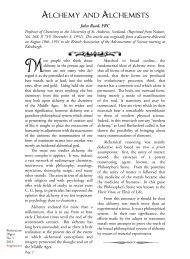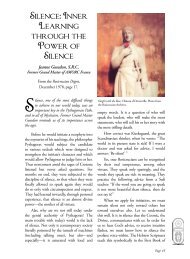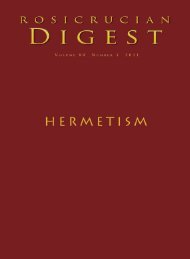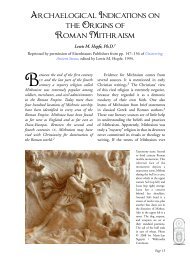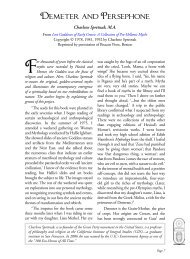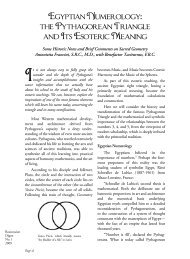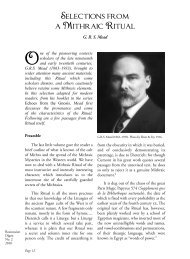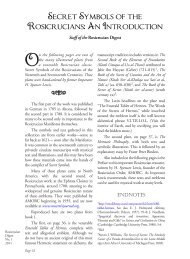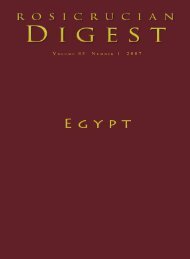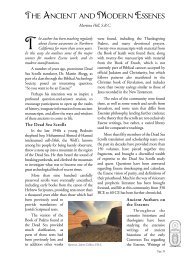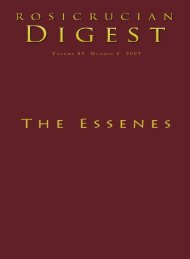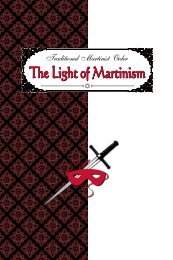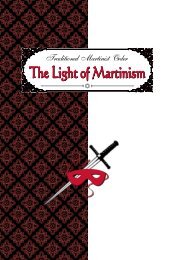Pythagorean Teachings across the Centuries - Rosicrucian Order
Pythagorean Teachings across the Centuries - Rosicrucian Order
Pythagorean Teachings across the Centuries - Rosicrucian Order
You also want an ePaper? Increase the reach of your titles
YUMPU automatically turns print PDFs into web optimized ePapers that Google loves.
Segonds. 3 vols., (Paris: Budé, 1979-1995). Available at<br />
www.animalrightshistory.org/library/porphyry/animalfood-bk1.htm.<br />
12 Porphyry, The Life of Pythagoras, chaps. 18-20. Trans.<br />
in Kenneth Sylvan Guthrie, The <strong>Pythagorean</strong> Sourcebook<br />
(1920), new edition edited by David R. Fideler (Grand<br />
Rapids, MI: Phanes Press, 1987), 126-127.<br />
13 Ibid., chap. 30, 129.<br />
14 Ibid., chap. 37, 130.<br />
15 Iamblichus, The Life of Pythagoras, chap. 12. Trans. in<br />
Kenneth Sylvan Guthrie, The <strong>Pythagorean</strong> Sourcebook<br />
(1920), new edition edited by David R. Fideler (Grand<br />
Rapids, MI: Phanes Press, 1987), 70.<br />
16 Ibid., chap. 13, 70-71.<br />
17 Ibid., chap. 14, 71.<br />
18 Ibid., chap. 15, 72-73.<br />
19 Amber Haque, “Psychology from Islamic Perspective:<br />
Contributions of Early Muslim Scholars and Challenges<br />
to Contemporary Muslim Psychologists,” Journal of<br />
Religion and Health 43 (4) (2004): 357-377 [363].<br />
20 cf. Robert Burton, The Anatomy of Melancholy,<br />
(London, H. Cripps, 1652), subsection 3, on and<br />
after line 3480, “Music a Remedy”: “But to leave all<br />
declamatory speeches in praise of divine music, I will<br />
confine myself to my proper subject: besides that<br />
excellent power it hath to expel many o<strong>the</strong>r diseases, it<br />
is a sovereign remedy against despair and melancholy,<br />
and will drive away <strong>the</strong> devil himself. Canus, a<br />
Rhodian fiddler, in Philostratus, when Apollonius was<br />
inquisitive to know what he could do with his pipe,<br />
told him, ‘That he would make a melancholy man<br />
merry, and him that was merry much merrier than<br />
before, a lover more enamoured, a religious man more<br />
devout.’ Ismenias <strong>the</strong> Theban, Chiron <strong>the</strong> centaur,<br />
is said to have cured this and many o<strong>the</strong>r diseases by<br />
music alone: as now <strong>the</strong>y do those, saith Bodine, that<br />
are troubled with St. Vitus’s Bedlam dance.” Available<br />
at www.gutenberg.org/files/10800/10800-8.txt; John<br />
Crellin “Humanities are <strong>the</strong> Hormones: A Tarantella<br />
Comes to Newfoundland. What Should We Do<br />
about It?” in MUNMED, Newsletter of <strong>the</strong> Faculty of<br />
Medicine, Memorial University of Newfoundland,<br />
1996. Available at www.med.mun.ca/munmed/84/<br />
crellin.htm; Steven K.H. Aung and Ma<strong>the</strong>w H.M.<br />
Lee, “Music, Sounds, Medicine, and Meditation: An<br />
Integrative Approach to <strong>the</strong> Healing Arts,” Alternative<br />
& Complementary Therapies, Oct. 2004, vol. 10, no.<br />
5: 266-270, available at www.liebertonline.com/doi/<br />
abs/10.1089/act.2004.10.266?journalCode=act.<br />
21 “Music Therapy,” at Wikipedia, http://en.wikipedia.<br />
org/wiki/Music_<strong>the</strong>rapy.<br />
22 Peter Kingsley, “Paths of <strong>the</strong> Ancient Sages: A<br />
<strong>Pythagorean</strong> History” <strong>Rosicrucian</strong> Digest, vol. 87, no.<br />
1 (2009), 2-9. See also: Kingsley, “From Empedocles<br />
to <strong>the</strong> Sufis: ‘The <strong>Pythagorean</strong> Leaven,’” Ancient<br />
Philosophy, 359-370; and Kingsley, “Empedocles and<br />
<strong>the</strong> Ismā’īlīs,” Ancient Philosophy, 395-396.<br />
23 Robert Zoller, “Hermetic Tradition” (New Library,<br />
1995); “The Hermetica as Ancient Science” (New<br />
Library, 1997), available at www.new-library.com/<br />
zoller/features/.<br />
24 Garth Fowden, The Egyptian Hermes: A Historical<br />
Approach to <strong>the</strong> Late Pagan Mind (Princeton, NJ:<br />
Princeton University Press, 1993).<br />
25 “Boethius” in Wikipedia. http://en.wikipedia.org/<br />
wiki/Boethius.<br />
26 “Quadrivium” at Wikipedia. http://en.wikipedia.org/<br />
wiki/Quadrivium.<br />
27 See Vincent Foster Hopper, Medieval Number<br />
Symbolism (New York: Copper Square Publishers, 1969).<br />
28 Capparelli, La sapienza di Pitagora.<br />
29 Leonardo Pisano - page 3: “Contributions to number<br />
<strong>the</strong>ory.” Encyclopædia Britannica Online, 2006.<br />
30 Parmanand Singh, “Acharya Hemachandra and <strong>the</strong><br />
(so called) Fibonacci Numbers” in Math, ed. Siwan ,<br />
20(1):28-30, 1986.<br />
31 See “Fibonnaci” at Wikipedia. http://en.wikipedia.<br />
org/wiki/Fibonnaci.<br />
32 “Fibonacci Number” at Wikipedia, http://<br />
en.wikipedia.org/wiki/Fibonacci_number.<br />
33 Giordano Bruno, Dialoghi italiani (Florence: Sansoni,<br />
1986).<br />
34 See “Tommaso Campanella” at Wikipedia. http://<br />
en.wikipedia.org/wiki/Tommaso_Campanella.<br />
35 “Luca Pacioli” at Wikipedia. http://en.wikipedia.org/<br />
wiki/Luca_Pacioli.<br />
36 Luca Pacioli, De Divina Proportione (Milan: Silvana,<br />
1982).<br />
37 See “Arabic Numbers” and “Hindu-Arabic<br />
Numeral System” at Wikipedia. http://en.wikipedia.<br />
org/wiki/Arabic_numbers and http://en.wikipedia.org/<br />
wiki/Hindu-Arabic_numeral_system.<br />
38 Peter Kingsley, “Paths of <strong>the</strong> Ancient Sages: a<br />
<strong>Pythagorean</strong> History” <strong>Rosicrucian</strong> Digest 87:1 (2009),<br />
2-9. See also Kingsley, “From Empedocles to <strong>the</strong> Sufis,<br />
‘The <strong>Pythagorean</strong> Leaven,’” Ancient Philosophy, 359-<br />
370, and Kingsley, “Empedocles and <strong>the</strong> Ismā’īlīs,”<br />
Ancient Philosophy, 395-396.<br />
39 See <strong>Rosicrucian</strong> Digest “The Essenes,” 85:2 (2007).<br />
40 Capparelli, La sapienza di Pitagora.<br />
41 A version of this essay was originally published in<br />
Rosa+Croce, no. 30 (Winter 2007), 34-48. It has been<br />
adapted and expanded by <strong>the</strong> Staff and Friends of <strong>the</strong><br />
<strong>Rosicrucian</strong> Research Library.<br />
Page xxxix




